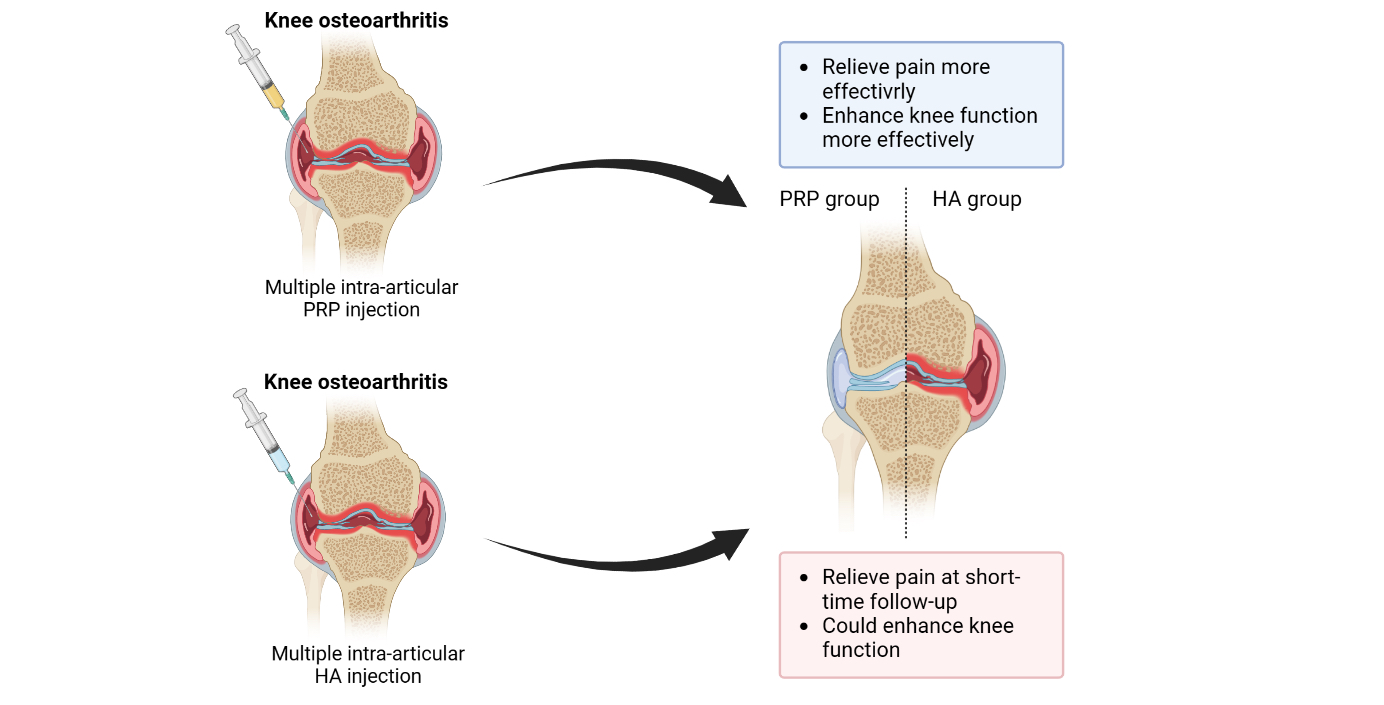Hyaluronic acid is a naturally occurring substance found in the fluid that cushions your joints. In arthritis, especially osteoarthritis, the joint fluid becomes thinner and less effective, causing pain and stiffness.
Hyaluronic acid injections—also known as viscosupplementation—involve injecting synthetic HA directly into the affected joint (usually the knee). The goal is to:
These injections are typically recommended for patients with mild to moderate osteoarthritis who haven’t responded well to over-the-counter medications or physical therapy.

Platelet-rich plasma (PRP) therapy uses components of your own blood to stimulate healing. The process involves:
PRP is thought to reduce inflammation, stimulate tissue regeneration, and slow the progression of arthritis.
FeatureHyaluronic Acid InjectionsPRP TherapySourceSynthetic or animal-derivedYour own blood (autologous)MechanismLubricates joint, cushions movementStimulates healing and reduces inflammationEffectiveness TimelineGradual relief over 4–6 weeksCan see improvement in 2–4 weeksDuration of Relief4–6 months (varies)6–12 months (varies)Best forMild to moderate osteoarthritisMild to moderate OA, younger patientsFDA Approved?Yes, for knee osteoarthritisNo (off-label use in arthritis)CostOften covered by insuranceUsually out-of-pocketSide EffectsMild swelling, pain at injection siteMild pain, swelling, rare flare-ups
However: Results can vary based on age, joint condition, and individual response.
You may be a good candidate for hyaluronic acid injections if:
PRP may be a better fit if:
There’s no one-size-fits-all answer. Both hyaluronic acid and PRP injections are effective for managing arthritis symptoms—but they work differently.
Always consult with a sports medicine doctor, orthopedic specialist, or rheumatologist to determine the best course of action for your arthritis management.
Whether you're considering hyaluronic acid injections or PRP therapy, talk to a qualified provider about your options. With the right treatment, you can reclaim mobility and reduce joint pain—without surgery.
If you’re struggling with joint pain due to arthritis, you’ve probably heard of hyaluronic acid injections and platelet-rich plasma (PRP) therapy. These are two of the most talked-about non-surgical arthritis treatments today. But how do they compare? Which one is right for your needs? In this blog, we’ll break down the benefits, differences, and what the research says about hyaluronic acid (HA) injections vs. PRP for arthritis—so you can make an informed decision for your joint health.
Hyaluronic acid is a naturally occurring substance found in the fluid that cushions your joints. In arthritis, especially osteoarthritis, the joint fluid becomes thinner and less effective, causing pain and stiffness.
Hyaluronic acid injections—also known as viscosupplementation—involve injecting synthetic HA directly into the affected joint (usually the knee). The goal is to:
These injections are typically recommended for patients with mild to moderate osteoarthritis who haven’t responded well to over-the-counter medications or physical therapy.

Platelet-rich plasma (PRP) therapy uses components of your own blood to stimulate healing. The process involves:
PRP is thought to reduce inflammation, stimulate tissue regeneration, and slow the progression of arthritis.
FeatureHyaluronic Acid InjectionsPRP TherapySourceSynthetic or animal-derivedYour own blood (autologous)MechanismLubricates joint, cushions movementStimulates healing and reduces inflammationEffectiveness TimelineGradual relief over 4–6 weeksCan see improvement in 2–4 weeksDuration of Relief4–6 months (varies)6–12 months (varies)Best forMild to moderate osteoarthritisMild to moderate OA, younger patientsFDA Approved?Yes, for knee osteoarthritisNo (off-label use in arthritis)CostOften covered by insuranceUsually out-of-pocketSide EffectsMild swelling, pain at injection siteMild pain, swelling, rare flare-ups
However: Results can vary based on age, joint condition, and individual response.
You may be a good candidate for hyaluronic acid injections if:
PRP may be a better fit if:
There’s no one-size-fits-all answer. Both hyaluronic acid and PRP injections are effective for managing arthritis symptoms—but they work differently.
Always consult with a sports medicine doctor, orthopedic specialist, or rheumatologist to determine the best course of action for your arthritis management.
Whether you're considering hyaluronic acid injections or PRP therapy, talk to a qualified provider about your options. With the right treatment, you can reclaim mobility and reduce joint pain—without surgery.